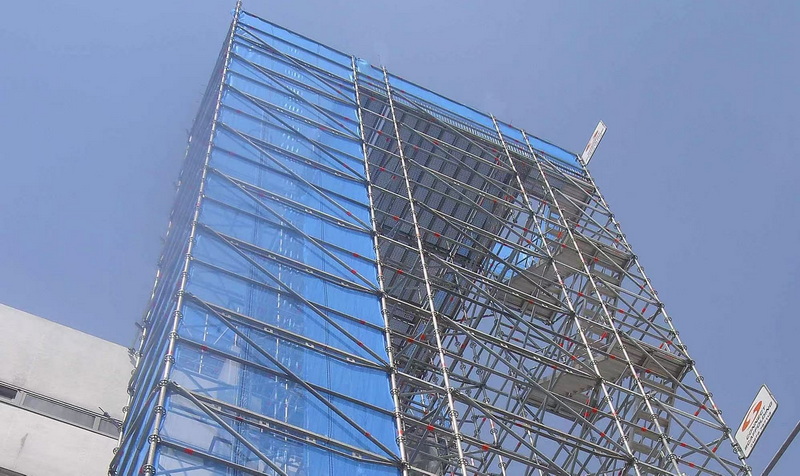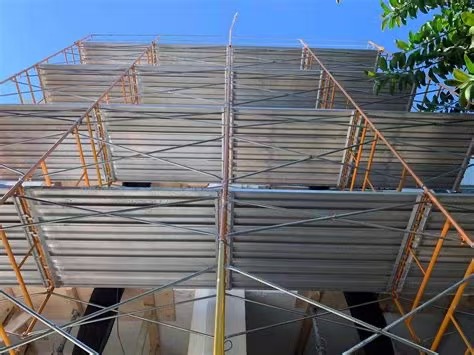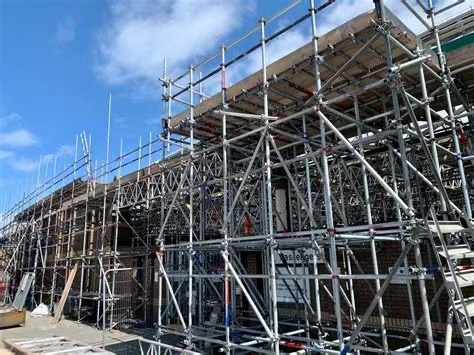Content Menu
● What Is Air Frame Scaffolding?
● Design and Structure
● Advantages of Air Frame Scaffolding in Residential Projects
>> 1. Portability and Ease of Assembly
>> 2. Versatility for Various Tasks
>> 3. Safety and Stability
>> 4. Cost-Effectiveness
>> 5. Adaptability to Tight Spaces
● Practical Applications in Residential Projects
>> Painting and Decorating
>> Renovation and Maintenance
>> Landscaping and Garden Work
>> Electrical and Plumbing Installations
>> Insulation and Drywall Installation
● Detailed Assembly Guide for Residential Use
>> Step 1: Site Preparation
>> Step 2: Frame Setup
>> Step 3: Platform Installation
>> Step 4: Height Adjustment
>> Step 5: Safety Features
>> Step 6: Inspection
● Safety Considerations for Residential Use
● Comparison with Other Scaffolding Types in Residential Projects
● Conclusion
● FAQ
>> 1. What is air frame scaffolding commonly used for in residential projects?
>> 2. Is air frame scaffolding safe for use on uneven ground?
>> 3. How quickly can air frame scaffolding be assembled and dismantled?
>> 4. Can air frame scaffolding be used for multi-story residential buildings?
>> 5. What maintenance is required for air frame scaffolding?
Air frame scaffolding, also known as A-frame scaffolding or frame scaffolding, is a widely used scaffolding system characterized by its triangular or rectangular frame design. It is popular in various construction, maintenance, and event applications due to its portability, ease of assembly, and safety features. This article explores the suitability of air frame scaffolding for residential projects, examining its design, benefits, safety considerations, and practical applications in residential construction and renovation.

What Is Air Frame Scaffolding?
Air frame scaffolding typically consists of prefabricated steel or aluminum frames connected by cross braces, forming a stable platform for workers to perform tasks at height. The frames are often shaped like an "A" or an "H," providing structural support and allowing for quick assembly and disassembly. The system is lightweight yet durable, making it ideal for various tasks including painting, plastering, electrical work, and general maintenance.
Design and Structure
- Triangular (A-frame) or Rectangular Frames: The frames are designed to be self-supporting with a wide base to enhance stability.
- Horizontal Platforms: Boards or planks are placed across the frames to create working platforms.
- Adjustable Legs: Many air frame scaffolds have adjustable legs to accommodate uneven ground or different working heights.
- Materials: Commonly made from steel for strength or aluminum for lightweight handling.
Advantages of Air Frame Scaffolding in Residential Projects
1. Portability and Ease of Assembly
Air frame scaffolding is lightweight and easy to transport, which is ideal for residential sites where space and access may be limited. The simple design allows for quick setup and dismantling, reducing labor time and costs. Workers can assemble the scaffold without specialized tools, which is a significant advantage for small residential contractors or DIY enthusiasts.
2. Versatility for Various Tasks
This scaffolding system is suitable for a range of residential tasks such as:
- Interior painting and plastering
- Electrical installations
- Window and roof repairs
- Landscaping and garden maintenance
- Installing siding or cladding
The modular nature of air frame scaffolding means it can be configured to fit different shapes and sizes of residential buildings, from small cottages to larger suburban homes.
3. Safety and Stability
Air frame scaffolding provides a stable and secure platform for workers. When properly erected on level ground with appropriate bracing and base plates, it meets safety standards for residential construction work. Guardrails and toe boards can be added for additional protection. The wide base of the A-frame design reduces the risk of tipping, and the cross braces enhance rigidity.
4. Cost-Effectiveness
Due to its reusable nature and minimal maintenance requirements, air frame scaffolding is a cost-effective solution for residential projects, especially for short-term or intermittent use. Renting air frame scaffolding is also a popular option for homeowners or small contractors who do not want to invest in purchasing equipment outright.
5. Adaptability to Tight Spaces
Residential sites often have limited space, especially in urban or suburban areas with narrow yards or driveways. Air frame scaffolding's compact footprint and modular design allow it to be set up in tight spaces where larger scaffolding systems would be impractical.
Practical Applications in Residential Projects
Painting and Decorating
Air frame scaffolding is ideal for painting both interior and exterior walls of houses. Its compact size allows it to fit into rooms and narrow spaces, providing a safe platform for painters to work efficiently. For exterior painting, the scaffolding can be extended along the length of the house, enabling painters to reach high walls without the need for ladders, which are less stable and more hazardous.
Renovation and Maintenance
For tasks such as repairing roofs, gutters, or installing new windows, air frame scaffolding offers the flexibility to adjust height and position easily, which is crucial in residential settings where work areas vary. It enables workers to carry tools and materials safely at height, improving efficiency and reducing the risk of accidents.
Landscaping and Garden Work
The scaffolding can be used for tree trimming or installing garden structures, providing a stable platform for workers to perform tasks safely. Its portability means it can be moved around the garden or yard without much effort.
Electrical and Plumbing Installations
In residential projects, electrical and plumbing work often requires access to ceilings and walls at various heights. Air frame scaffolding provides a secure platform for electricians and plumbers to install wiring, pipes, and fixtures safely without the need for ladders.
Insulation and Drywall Installation
During insulation or drywall installation, workers need a stable surface to stand on while handling large panels. Air frame scaffolding supports these tasks by offering a broad platform that can be adjusted to the required height.

Detailed Assembly Guide for Residential Use
Step 1: Site Preparation
- Clear the area where the scaffolding will be erected.
- Ensure the ground is level and firm. Use base plates or mudsills to stabilize the scaffold on soft or uneven ground.
Step 2: Frame Setup
- Position the first pair of frames at the desired location.
- Connect horizontal cross braces between the frames to form a rigid structure.
Step 3: Platform Installation
- Lay scaffold planks or platforms across the horizontal braces.
- Secure the planks to prevent movement.
Step 4: Height Adjustment
- Use adjustable legs to level the scaffold if the ground is uneven.
- Add additional frames and braces to increase height as needed.
Step 5: Safety Features
- Install guardrails and toe boards on platforms above 2.4 meters (8 feet).
- Check all connections and braces for tightness.
Step 6: Inspection
- Conduct a thorough inspection before use.
- Check for any signs of damage, loose fittings, or instability.
Safety Considerations for Residential Use
- Stable Base: Ensure the scaffold is erected on a firm, level surface using base plates and mudsills if necessary.
- Bracing: Proper vertical and horizontal bracing must be installed to prevent sway and collapse.
- Load Limits: Adhere to manufacturer's load ratings to avoid overloading the scaffold with workers and materials.
- Inspection: Regular inspections before and during use are essential to identify any damage or instability.
- Guardrails: For platforms above 2.4 meters (8 feet), guardrails and toe boards should be installed to prevent falls.
- Weather Conditions: Avoid using scaffolding in high winds or heavy rain, which can compromise stability.
- Training: Workers should be trained in scaffold assembly, use, and safety protocols.
Comparison with Other Scaffolding Types in Residential Projects
| Feature | Air Frame Scaffolding | Tube and Coupler Scaffolding | Mobile Scaffold Towers |
| Portability | High | Moderate | High |
| Assembly Time | Quick | Longer | Quick |
| Flexibility | Moderate (modular frames) | Very High (customizable) | Moderate |
| Cost | Cost-effective | Higher due to complexity | Moderate |
| Stability | Good for low to medium heights | Excellent for all heights | Good for low to medium heights |
| Suitability for Tight Spaces | Excellent | Moderate | Excellent |
| Weight | Lightweight (especially aluminum) | Heavy | Lightweight |
Air frame scaffolding strikes a balance between ease of use, cost, and safety for most residential projects, making it a preferred choice for many contractors.
Conclusion
Air frame scaffolding is highly suitable for residential projects due to its portability, ease of assembly, versatility, and safety features. It supports a wide range of residential construction and maintenance tasks efficiently and cost-effectively. When properly used with adherence to safety standards, air frame scaffolding enhances worker safety and project productivity in residential environments. Its adaptability to tight spaces and quick setup make it particularly advantageous for homeowners, small contractors, and renovation specialists. For multi-story residential buildings or complex projects, additional scaffolding systems may be necessary, but for most typical residential applications, air frame scaffolding is an excellent choice.

FAQ
1. What is air frame scaffolding commonly used for in residential projects?
Air frame scaffolding is commonly used for interior and exterior painting, plastering, electrical work, roof repairs, window installation, and garden maintenance in residential projects.
2. Is air frame scaffolding safe for use on uneven ground?
Yes, many air frame scaffolds come with adjustable legs to accommodate uneven surfaces, but it is crucial to ensure the base is stable and properly supported with base plates or mudsills to maintain safety.
3. How quickly can air frame scaffolding be assembled and dismantled?
Due to its simple design and lightweight materials, air frame scaffolding can be assembled and dismantled quickly, often within a few hours depending on the size of the scaffold and the experience of the workers.
4. Can air frame scaffolding be used for multi-story residential buildings?
Air frame scaffolding is best suited for low-rise residential buildings or single-story projects. For multi-story structures, more robust scaffolding systems may be required to ensure safety and stability.
5. What maintenance is required for air frame scaffolding?
Regular inspections for damage, rust, or loose components are necessary. Cleaning and protective coatings can extend the lifespan of the scaffold. Proper storage when not in use also helps maintain its condition.






















